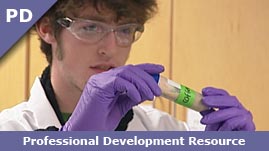Teachers' Domain - Digital Media for the Classroom and Professional Development
User: Preview




In this classroom-practice video created for Teachers' Domain Professional Development, high school teacher Diane Provenzano leads her biotechnology class through a lab activity in which students produce cheese curds using two different enzymes: a nonrecombinant enzyme (rennin) and a recombinant enzyme (chymosin). Students also test the effects of different types of milk on curd formation. The accompanying PDF document outlines the process.
Chymosin Diagram (Document)
Historically, cheese was made using an enzyme isolated from calves. A substance called rennet was harvested from frozen calf stomachs, and then an enzyme called rennin was purified from the rennet. Nursing calves need rennin to digest milk. Purified rennin is necessary to produce firm cheeses.
Rennin reacts with the milk protein casein and causes it to clump together or form curds. Formation of these curds is the first step in producing hard cheeses. However, because it was difficult to isolate enough rennin from calves to meet the large global demand for cheese, scientists worked to produce the enzyme using biotechnology. The rennin gene was isolated from calves' stomachs, cloned into a plasmid, and transformed into E. coli. The bacteria were then used to produce the recombinant enzyme chymosin. To see an illustration of this process, refer to the Chymosin Diagram.
To produce large quantities of chymosin, which can then be isolated and purified for commercial cheese production, bacteria are grown in bioreactors. A large part of global cheese production is conducted using recombinant chymosin.
 Loading Standards
Loading Standards Teachers' Domain is proud to be a Pathways portal to the National Science Digital Library.
Teachers' Domain is proud to be a Pathways portal to the National Science Digital Library.
